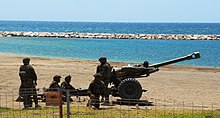This article needs additional citations for verification. (September 2011) |
| Spanish Legion | |
|---|---|
| Legión Española | |
 Badge of the Spanish Legion | |
| Founded | 20 September 1920 |
| Country | |
| Allegiance | "God, King, Spain" |
| Branch | |
| Type | Light infantry, shock troops |
| Size | 8,000 |
| Garrison/HQ |
|
| Nickname(s) | Novios de la muerte ("Grooms of Death") |
| Motto(s) | ¡Legionarios a luchar! ¡Legionarios a morir! ("Legionnaires, to fight! Legionnaires, to die!") |
| March |
|
| Anniversaries | 20 September |
| Engagements | |
| Commanders | |
| Notable commanders | José Millán-Astray Francisco Franco |





For centuries, Spain recruited foreign soldiers to its army, forming the foreign regiments (Infantería de línea extranjera) such as the Regiment of Hibernia (formed in 1709 from Irishmen who fled their own country in the wake of the Flight of the Earls and the penal laws). However, the specific unit of the Spanish Army and Spain's Rapid Reaction Force, now known as the Spanish Legion (Legión Española, La Legión), and informally known as the Tercio or the Tercios, is a 20th-century creation. It was raised in the 1920s to serve as part of Spain's Army of Africa. The unit, which was established in January 1920 as the Spanish equivalent of the French Foreign Legion, was initially known as the Tercio de Extranjeros ("Tercio of foreigners"), the name under which it began fighting in the Rif War of 1921–1926.
Over the years, the force's name has changed from Tercio de Extranjeros to Tercio de Marruecos (when the field of operations targeted Morocco), and by the end of the Rif War it became the "Spanish Legion", with several "tercios" as sub-units.
The Legion played a major role in the Nationalist forces in the Spanish Civil War. In post-Franco Spain, the modern Legion has undertaken tours of duty in the Yugoslav Wars, Afghanistan, Iraq and Operation Libre Hidalgo UNIFIL.
- ^ "Archived copy" (PDF). Archived from the original (PDF) on 2015-04-13. Retrieved 2015-05-08.
{{cite web}}: CS1 maint: archived copy as title (link)